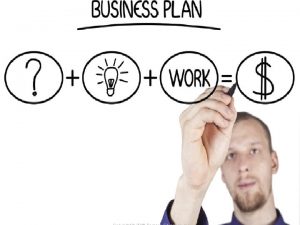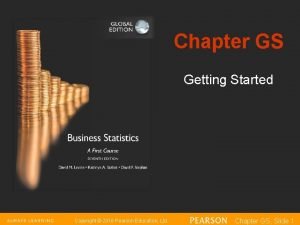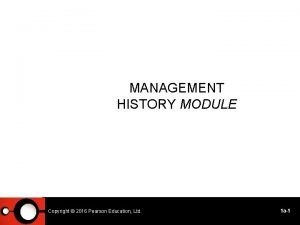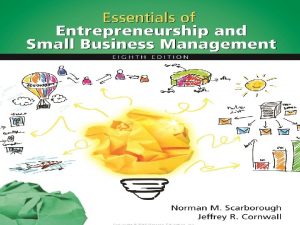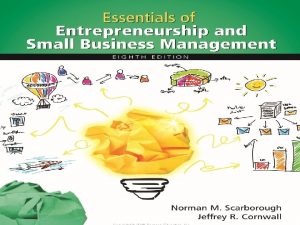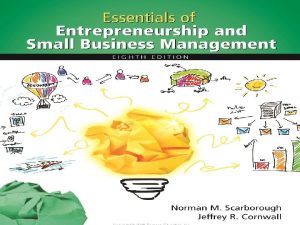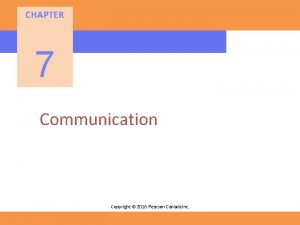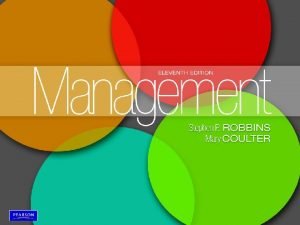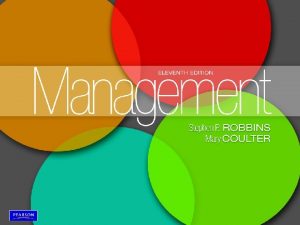Copyright 2016 Pearson Education Inc 1 Section 3

































- Slides: 33

Copyright © 2016 Pearson Education, Inc. 1

Section 3: Launching the Business 10 Pricing and Credit Strategies Copyright © 2016 Pearson Education, Inc. 10 -2

Learning Objectives v Discuss the relationships among pricing, image, competition, and value. v Describe effective pricing techniques for introducing new products or services and for existing ones. v Explain the pricing methods and strategies for retailers, manufacturers, and service firms. v Describe the impact of credit on pricing. Copyright © 2016 Pearson Education, Inc. 10 - 3

Introduction v. Pricing: v Is governed both by art and science. v Requires balancing a multitude of complex forces. v Influences every aspect of a small company. v Is an important signal of value to customers. v Involves both math and psychology. v Has a greater impact on profits than corresponding increases in unit volume or reductions in costs. Copyright © 2016 Pearson Education, Inc. 10 - 4

Impact of Pricing and Cost Improvements on Profitability Copyright © 2016 Pearson Education, Inc. 10 - 5

Image, Competition, Value v Companies that take a strategic approach to pricing and monitor its results can raise their sales revenue between 1 and 8% v. Example: Duane Reade Copyright © 2016 Pearson Education, Inc. 10 - 6

Price Conveys Image v Price sends important signals to customers: quality, prestige, uniqueness, etc. v Common small business mistake: charging prices that are too low and failing to recognize extra value, service, quality, and other benefits they offer. v The key is to understand the target market and identify how much customers are willing to pay rather than how much to charge. Copyright © 2016 Pearson Education, Inc. 10 - 7

Competition and Pricing v. Must take into account competitors’ prices, but it is not always necessary to match or beat them. v. Key is to differentiate a company’s products and services. v. Price wars often eradicate companies’ profits and scar an industry for years. v. Best strategy: Stay out of a price war! Copyright © 2016 Pearson Education, Inc. 10 - 8

The Reality of Setting Prices Copyright © 2016 Pearson Education, Inc. 10 - 9

Focus on Value v The “right” price for a product or service depends on the value it provides for a customer. v Two aspects of price: v. Objective value v. Perceived value: determines the price customers are willing to pay. v Value is not synonymous with low price. v. Fighter brand Copyright © 2016 Pearson Education, Inc. 10 - 10

Dealing with Rising Costs v. Communicate with customers v. Add a surcharge v. Focus on improving efficiency v. Consider absorbing cost increases v. Eliminate discounts, coupons, and freebies v. Use cheaper raw materials v. Raise prices incrementally and consistently Copyright © 2016 Pearson Education, Inc. 10 - 11

Dealing with Rising Costs (continued) v Modify the product or service to lower its cost v Offer products in smaller sizes or quantities v Differentiate your company and its products and services from the competition v Anticipate rising costs and try to lock in prices of raw materials early v Emphasize the value of your company’s product or service to customers Copyright © 2016 Pearson Education, Inc. 10 - 12

What Determines Price? Copyright © 2016 Pearson Education, Inc. 10 - 13

Introducing a New Product v Three Goals: 1. Getting the product accepted v Revolutionary products v Evolutionary products v Me-too products 2. Maintaining market share as competition grows 3. Earning a profit Copyright © 2016 Pearson Education, Inc. 10 - 14

Introducing a New Product (continued) v Three basic pricing strategies: 1. Penetration 2. Skimming 3. Life cycle pricing Copyright © 2016 Pearson Education, Inc. 10 - 15

Pricing Established Goods v Odd pricing v Price lining v Freemium pricing v Dynamic pricing v Leader pricing v Geographic pricing v Discounts (markdowns) Copyright © 2016 Pearson Education, Inc. 10 - 16

Pricing Established Goods (continued) v Bundling v Optional-product pricing v Captive-product pricing v By-product pricing v Suggested retail prices v Follow-the-leader pricing Copyright © 2016 Pearson Education, Inc. 10 - 17

Pricing Strategies: Markup If a shirt costs $14, and a retailer plans to sell it for $30, the markup would be: Copyright © 2016 Pearson Education, Inc. 10 - 18

Costs and Markup Calculations for i. Pad and Surface Tablets Copyright © 2016 Pearson Education, Inc. 10 - 19

Initial Dollar Markup and Retail Price Copyright © 2016 Pearson Education, Inc. 10 - 20

Pricing for Manufacturers v The most commonly used pricing technique for manufacturers is cost-plus pricing: v A manufacturer establishes a price that covers the cost of direct materials, direct labor, factory overhead, selling and administrative costs, and a desired profit margin. Copyright © 2016 Pearson Education, Inc. 10 - 21

Cost-Plus Pricing Components Copyright © 2016 Pearson Education, Inc. 10 - 22

Direct Costing and Pricing v. Absorption costing: v Traditional method of product costing in which all manufacturing and overhead costs are absorbed into the product’s total cost. v. Variable or direct costing: v Product costing method that includes in the product’s costs only those costs that can vary directly with the quantity produced. Copyright © 2016 Pearson Education, Inc. 10 - 23

Break-Even Pricing Break-even selling price = Profit + (Variable cost per unit x Quantity produced) + Total fixed cost Quantity produced Copyright © 2016 Pearson Education, Inc. 10 - 24

Direct Costing and Pricing v. To establish a reasonable, profitable price for service, small business owners must know the cost of materials, direct labor, and overhead for each unit of service they provide. Price Total cost per hour = productive hour ÷ (1 -net profit as a % of sales) Copyright © 2016 Pearson Education, Inc. 10 - 25

Impact of Credit on Pricing v 58% of small business owners say that their customers expect them to accept credit cards. v But, companies incur an additional cost to offer this service. v Three options for selling on credit: v Credit (and debit cards) v Installment credit v Trade credit Copyright © 2016 Pearson Education, Inc. 10 - 26

Multiple Forms of Payment Percentage of Customers Who Shop Only at Businesses That Accept Multiple Forms of Payment Copyright © 2016 Pearson Education, Inc. 10 - 27

Consumer Credit v Credit cards: typical consumer has 3. 75 credit cards. v Research: Customers who use credit cards make purchases that are 112% higher than if they had used cash. v On a typical $100 credit card purchase, cost to business = $2. 33. v. Interchange fee Copyright © 2016 Pearson Education, Inc. 10 - 28

Typical Credit Card Transaction Copyright © 2016 Pearson Education, Inc. 10 - 29

E-Commerce and Credit Cards v About 0. 9% of online credit card transactions are fraudulent. v To minimize credit card fraud: v. Use an address verification system v. Require a CVV 2 number v. Check customers IP addresses v. Monitor Web site activity with analytics v. Verify large orders v. Post notices on Web site that your company uses anti-fraud technology v. Contact the credit card company or bank that issued the card Copyright © 2016 Pearson Education, Inc. 10 - 30

Consumer Credit (continued from 10 -28) v. Debit cards v. Shoppers make almost 53 billion debit card transactions, totaling $2. 1 trillion each year. v. Mobile wallets: v. Applications that link a smart phone or tablet to a credit or debit card, transforming the device into a digital wallet. v. Growing form of payment. v. Installment credit v. Trade credit v. Layaway Copyright © 2016 Pearson Education, Inc. 10 - 31

Conclusion v Pricing techniques impact every aspect of a company including: v Image v Customers v Cash flow v Profits Copyright © 2016 Pearson Education, Inc. 10 - 32

Copyright © 2016 Pearson Education, Inc. 10 - 33
 2016 pearson education inc
2016 pearson education inc 2016 pearson education inc
2016 pearson education inc 2016 pearson education inc
2016 pearson education inc 2016 pearson education inc
2016 pearson education inc 2016 pearson education inc
2016 pearson education inc 2016 pearson education inc
2016 pearson education inc 2016 pearson education inc
2016 pearson education inc 2016 pearson education inc
2016 pearson education inc 2016 pearson education inc
2016 pearson education inc 2016 pearson education inc
2016 pearson education inc 2016 pearson education inc
2016 pearson education inc 2016 pearson education inc
2016 pearson education inc Pearson canada inc.
Pearson canada inc. 2016 pearson education inc
2016 pearson education inc 2017 pearson education ltd
2017 pearson education ltd 2017 pearson education inc
2017 pearson education inc 2010 pearson education inc
2010 pearson education inc Copyright 2009
Copyright 2009 Copyright pearson education inc
Copyright pearson education inc 2014 pearson education inc
2014 pearson education inc Copyright 2010 pearson education inc
Copyright 2010 pearson education inc Copyright 2010 pearson education inc
Copyright 2010 pearson education inc Copyright by pearson education inc. answers
Copyright by pearson education inc. answers Copyright 2003 pearson education inc
Copyright 2003 pearson education inc Copyright 2009 pearson education inc
Copyright 2009 pearson education inc 2015 pearson education inc
2015 pearson education inc Copyright 2010 pearson education inc
Copyright 2010 pearson education inc Copyright 2010 pearson education inc
Copyright 2010 pearson education inc Copyright 2010 pearson education inc
Copyright 2010 pearson education inc 2010 pearson education inc
2010 pearson education inc Copyright 2010 pearson education inc
Copyright 2010 pearson education inc Composition copyright example
Composition copyright example Pearson education inc all rights reserved
Pearson education inc all rights reserved Copyright 2009 pearson education inc
Copyright 2009 pearson education inc
